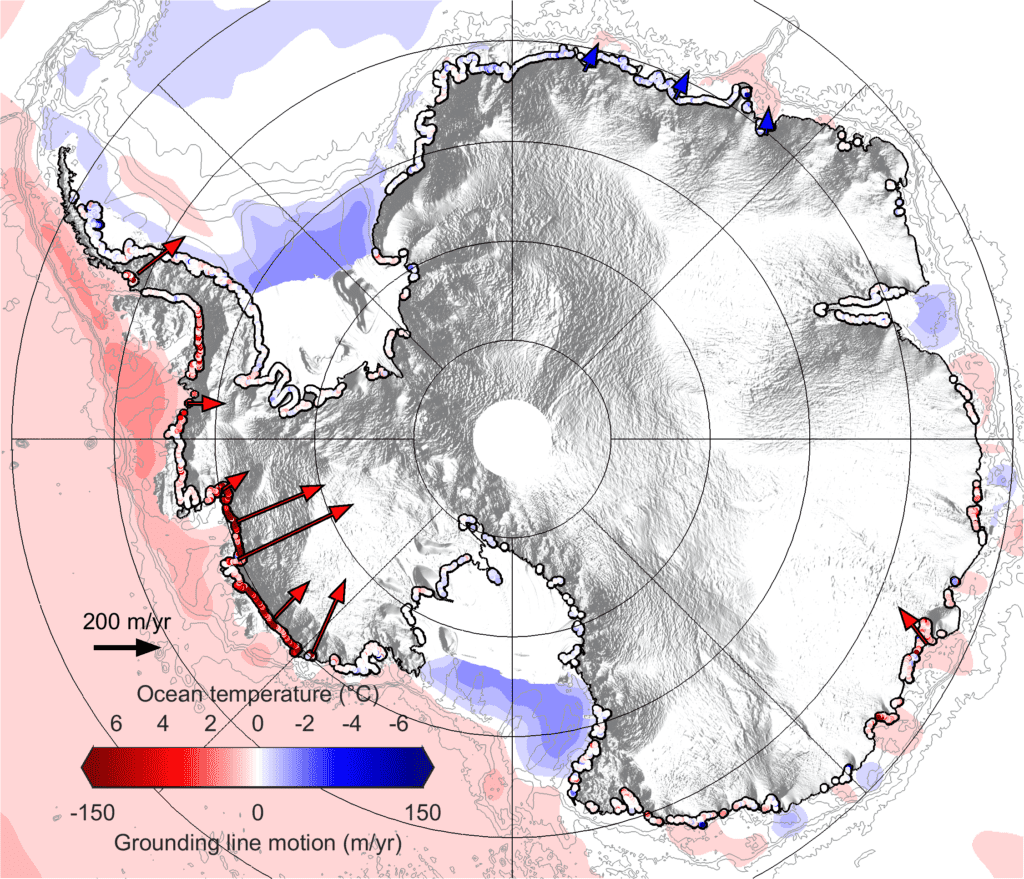Antarctica’s ice sheet is melting from below– warm ocean water is causing melting that can’t really be seen from the surface. To visualize this below the surface melting, researchers from the UK Center for Polar Observation and Modeling at the University of Leeds have used satellite images. Some glaciers on the continent are retreating by 125 m (410 feet) per year!

Ice sheets have a leading edge, called a “grounding line.” It is where the base of the glacier leaves the sea floor and starts to float. It usually lies a kilometer or more below the sea level.
“Ice that is taken from the Antarctic continent and melts into the world’s oceans, will raise global sea levels. This is not the case for ice that is already floating on the ocean. The grounding line exactly separates the floating parts, so-called ice shelves, from the grounded parts of Antarctica, which rest on the seafloor or on the rock above sea level. So technically, one can say that only a shrinking ice volume inside the grounding line will raise sea levels. Retreating grounding lines then mean that the area, in which Antarctica rests firmly on the ground, is getting smaller, and by that also its capacity to store water and prevent it from going into the ocean in the future,” said leading author Dr Hannes Konrad from the University of Leeds to ZME Science.
Even submersibles have trouble accessing the grounding line so remote sensing data was used in this study. The European Space Agency’s CryoSat-2 was used to track 16,000 km of Antarctic coast. The satellite works by measuring changes in the elevation of the ice sheet. Using sea floor geometry, the principle of buoyancy, and knowledge of the glacier, this information can be used to estimate the thickness of floating ice.
“We were delighted at how well CryoSat-2 is able to detect the motion of Antarctica’s grounding lines. They are impossible places to access from below, and usually invisible on the ground, so it’s a fantastic illustration of the value of satellite measurements for identifying and understanding environmental change,” said study co-author Professor Andy Shepherd, from the School of Earth and Environment at Leeds.
Between 2010 and 2016, 1, 463 km2 (564.86 square miles) of underwater ice shelves melted. The melting has been extremely fast at eight of the sixty-five biggest glaciers. West Antarctic was the most strongly affected. The rate of ice melt at these locations is much higher than it has been previously since the last ice age—up to five times quicker! The baseline-melting rate of glaciers is about 25 meters (82 feet) per year.

“Our study provides clear evidence that retreat is happening across the ice sheet due to ocean melting at its base, and not just at the few spots that have been mapped before now. This retreat has had a huge impact on inland glaciers, because releasing them from the sea bed removes friction, causing them to speed up and contribute to global sea level rise,” said Konrad.
Once ice shelves have melted at the bottom, it speeds up the melting process for the rest of the glacier. This piece of news identifies another factor that influences the melting of the Antarctic ice sheet, and sea levels.
“Grounding lines of a number of indidual ice streams in Antarctica have been studied before and found retreating, so our finding of a net retreat in Antarctica does not come as a big surprise. One thing that maybe wasn’t so clear before is how grounding lines react to changes in the enviroment very differently in different places and at different times. For example, the grounding line of Pine Island Glacier (a massive ice stream and one of the largest single contributors to sea level rise in recent years) which has retreated extremely fast since the early 1990s, at about 1 km per year or more, has been almost stable since 2011. Or in East Antarctica, one can find one ice stream retreating and the neighbouring one advancing,” said Konrad to ZME Science.
The ice sheet behaves in a complex manner—although the melting of grounding lines has increased, there are some areas where it has slowed down. The Pine Island Glacier was one of the quickest retreating glaciers on Antarctica, but now the below the surface melting has come to a halt.
Now we know of a new factor that influences the melting of ice sheet and help us to understand it better.
Journal reference: Konrad et al (2018) Net retreat of Antarctic glacier grounding lines. Nature Geoscience.
http://dx.doi.org/10.1038/s41561-018-0082-z


